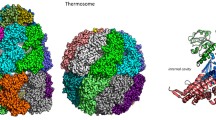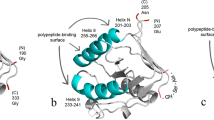Abstract
Two β-galactosidase fusion proteins, VP1LAC and LACVP1, contain the same viral capsid protein fused to either the amino or carboxy termini of the enzyme, respectively. Once produced in Escherichia coli, these fusions undergo a rapid, site-limited proteolysis releasing active β-galactosidase fragments indistinguishable from the native enzyme. In vivo binding preferences of DnaK and GroEL chaperones for these homologous protein fragments have been observed, indicating that accessibility of chaperone target sites in degradation products could be determined by the folding pathway undergone by the larger polypeptide before the proteolytic attack.
Similar content being viewed by others
References
Becker J, Craig EA (1994) Heat-shock proteins as molecular chaperones. Eur. J. Biochem. 219: 11–23.
Corchero JL, Viaplana E, Benito A, Villaverde A (1996) The position of the heterologous domain can influence the solubility and proteolysis of β-galactosidase fusion proteins. J. Biotechnol. 48: 191–200.
Corchero JL, Cubarsí R, Enfors S-O, Villaverde A (1997) Limited in vivo proteolysis of aggregated proteins. Biochem. Biophys. Res. Commun. 237: 325–330.
Corchero JL, Villaverde A (1998) Plasmid maintenance in Escherichia coli recombinant cultures is dramatically, steadily and specifically influenced by features of the encoded proteins. Biotechnol. Bioeng. 58: 625–632.
de Crouy-Chanel A, El Yaagoubi A, Kohiyama M, Richarme G (1995) Reversal by GroES of the GroEL preference from hydrophobic amino acids toward hydrophilic amino acids. J. Biol. Chem. 270: 10571–10575.
Feliu JX, Cubarsí R, Villaverde A (1998) Optimized release of recombinant proteins by ultrasonication of E. coli cells. Biotechnol. Bioeng. 58: 536–540.
Geourgiou G, Valax P (1996) Expression of correctly folded proteins in Escherichia coli. Curr. Opin. Biotechnol. 7: 190–197.
Goloubinoff P, Diamant S, Weiss C, Azem A (1997) GroES binding regulates GroEL chaperonin activity under heat shock. FEBS Lett. 407: 215–219.
Gustavsson K, Bergman T, Veide A, Enfors S-O (1997) In vitro complex-formation between the molecular chaperone DnaK and staphylococcal protein A derivatives produced in Escherichia coli and its use in the purification of DnaK. Biotechnol. Appl. Biochem. 25: 173–180.
Hellebust H, Uhlén M, Enfors S-O (1990) Interaction between heat shock protein DnaK and recombinant staphylococcal protein A. J. Bacteriol. 172: 5030–5034.
Jacobson RH, Zhang X-J, DuBose RF, Matthews BW (1994) Three-dimensional structure of beta-galactosidase from E. coli. Nature 369: 761–766.
Langer T, Lu C, Echols H, Flanagan J, Hayer MK, Hartl FU (1992) Successive action of DnaK, DnaJ and GroEL along the pathway of chaperone-mediated protein folding. Nature 356: 683–689.
Maniatis D, Sambrook J, Fritsch EF (1982) Molecular Cloning: A Laboratory Manual. Cold Spring Harbor, NY: Cold Spring Harbor Laboratory Press.
Meissner PS, Sisk WP, Berman ML (1987) Bacteriophage lambda cloning system for the construction of directional cDNA libraries. Proc. Natl. Acad. Sci. USA 84: 4171–4175.
Miller JH (1972) Experiments in Molecular Genetics. Cold Spring Harbor, NY: Cold Spring Harbor Laboratory Press.
Richarme G, Kohiyama M (1994) Amino acid specificity of the Escherichia coli chaperone GroEL (heat shock protein 60). J. Biol. Chem. 269: 7095–7098.
Rüdiger S, Germeroth L, Schneider-Mergener J, Bukau B (1997) Substrate specificity of the DnaK chaperone determined by screening cellulose-bound peptide libraries. EMBO J. 16: 1501–1507.
Ruddon RW, Bedows E (1997) Assisted protein folding. J. Biol. Chem. 272: 3125–3128.
Sachdev D, Chirgwin JM (1998) Order of fusions between bacterial and mammalian proteins can determine solubility in Escherichia coli. Biochem. Biophys. Res. Commun. 244: 933–937.
Schauder B, Blöcker H, Frank R, McCarthy JEG (1987) Inducible expression vectors incorporating the Escherichia coli atpE translational initiation region. Gene 72: 279–283.
Sherman MY, Goldberg AL (1992) Involvement of the chaperonin dnaK in the rapid degradation of a mutant protein in Escherichia coli. EMBO J. 11: 71–77.
Ullmann A (1984) One-step purification of hybrid proteins which have beta-galactosidase activity. Gene 29: 27–31.
Veinger L, Diamant S, Buchner J, Goloubinoff P (1998) The small heat-shock protein IbpB from Escherichia coli stabilizes stress-denatured proteins for subsequent refolding by a multichaperone network. J. Biol. Chem. 273: 11032–11037.
Viaplana E, Feliu JX, Corchero JL, Villaverde A (1997) Reversible activation of a cryptic cleavage site within E. coli β-galactosidase in β-galactosidase fusion proteins. Biophys. Biochem. Acta 1343: 221–226.
Wall JG, Plückthum A (1995) Effects of overexpressing folding modulators on the in vivo folding of heterologous proteins in Escherichia coli. Curr. Opin. Biotechnol. 6: 507–516.
Weickert MJ, Doherty DH, Best EA, Olins PO (1996) Optimization of heterologous protein production in Escherichia coli. Curr. Opin. Biotechnol. 7: 494–499.
Weissman JS, Kashi Y, Fenton WA, Horwich AL (1994) GroEL-mediated protein folding proceeds by multiple rounds of binding and release of nonnative forms. Cell 78: 693–702.
Author information
Authors and Affiliations
Rights and permissions
About this article
Cite this article
Boels, K., Carrió, M.M., Arís, A. et al. Distinct chaperone affinity to folding variants of homologous recombinant proteins. Biotechnology Letters 21, 531–536 (1999). https://doi.org/10.1023/A:1005537431259
Issue Date:
DOI: https://doi.org/10.1023/A:1005537431259




